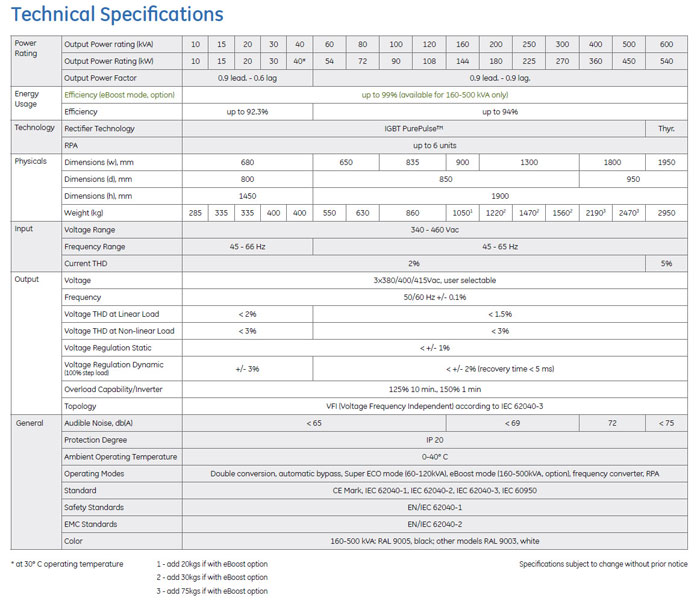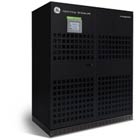
SG Series UPS – 50 Hz, 10-600kVA, 400Vac
Delivering Best-in-Class Efficiency with eBoost Technology
The GE SG Series is one of the most efficient and reliable Three Phase UPS Systems, providing best-in- class output performance and critical power protection for your data center needs. The SG Series UPS solutions are designed and optimized to provide high efficiency at part load conditions.
The SG Series UPS assures low input current harmonic distortion and best-in-class output voltage regulation and dynamic response. This helps customers save operational costs while implementing environmentally-friendly solutions.
| Low total cost of ownership | |
|---|---|
| High efficiency in double conversion up to 94% and eBoost mode of operation up to 99% provides substantial savings in direct and indirect energy cost. | |
| eBoost*** operation minimizes efficiency losses providing annual power & cooling savings up to $300k for 5MW data center | |
| PurePulse IGBT rectifier keeps your supply network clean and provides advantages in installations by reducing size of circuit breaker, cables and generator. | |
| Easier Installation and Configuration Flexibility | |
|---|---|
| True front access for operation and maintenance, reduces mean time to repair (MTTR) | |
| Smaller size reduced installation and operational foot print | |
| Redundant Parallel Architecture (RPA) provides reliability, redundancy and scalability | |
| Parallel up to 6 UPS Modules | |
| High Performance and Availability | |
|---|---|
| Enhanced output performance to protect and supply modern IT load with leading power factor (0.9) without derating | |
| Excellent dynamic performance and low output voltage distortion | |
| Inverter zig-zag isolation transformer provide better short circuit capability and load galvanic separation | |
*** eBoost option is available on 160-500 kVA UPS model
High Efficiency
Energy Efficiency is Our Focus
The GE SG Series is one of the most energy efficient double-conversion UPS with output transformer topology in the industry, and provides world-class energy efficiency across the operating load range.
True efficiency
GE’s UPS performance is optimized at 50-75% load operation, as this is the most common operating range. The optimization of the SG Series includes selecting all major power chain components based on maximizing the component efficiency at part load conditions. See the Technical Specifications tab for efficiencies of the different SG UPS models.
This avoids any surprise in cooling system design and in economical evaluation of energy consumption over the life cycle, ensuring peace of mind for your investment.
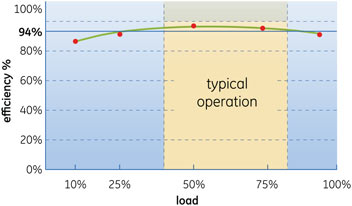
Ultra-High Efficiency Mode
What is eBoost**?
e = high efficiency up to 99%
Boost = fast transfer to inverter < 2ms
eBoost
Energy consumption is a critical issue for IT organizations as their datacenter energy demands continue to grow. Their goal is to reduce cost and keep the datacenter running. IT organizations can reduce energy consumption costs & system reliability with GE’s eBoost technology.
Technology Features
- Up to 99% UPS efficiency
- Compliant to ITI (CBEMA) curve during transient events
- Patented power electronics and magnetics ensures less than 2ms transfer time to inverter
- Patented power conditioning/filtering design via bypass inductor and output transformer/capacitor while in eBoost mode
- Battery trickle charge in eBoost operating mode
- Up to 4 MW UPS capacity using paralleled modules
eBoost Savings
eBoost operation provides considerable energy life cycle cost savings ranging from $0.5MM to $7MM**. Savings are dependent upon load, power costs and life cycle duration (years).
- * Assumptions:
- Power Cost = $0.10/kw-hr
- Operating Hrs/Year = 8.760
- Confirmation = S+S operating at 50% of capacity
High Performance
Input Performance
Robust Rectifier for Wide Input Range
The wide AC input voltage and frequency window avoids unnecessary battery discharge even when operating from an unstable AC source (i.e. diesel generator).
Programmable Soft Start
Allows the rectifier to ramp up in a programmable time period (0-30 seconds) eliminating in-rush current. This feature reduces the need of oversizing the input power system (gensets, feeder cables, and overcurrent devices).
Generator Compatibility
User-programmable features such as slew rate, phase angle rate-of-change and voltage rate-of-change allow the UPS to quickly sync to a genset during emergency back-up. GE’s optional input filter also has user-programmable features ensuring quick and continuous synchronization to generator voltage.
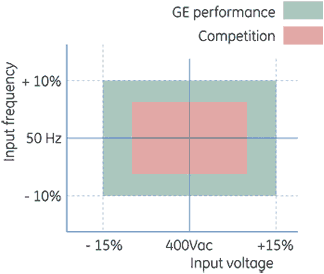
Output Performance
Total Harmonic Distortion (THD)
A distorted output voltage waveform affects the proper function of the load’s equipment. The SG Series has very low output voltage THD, even with connected 100% unbalanced or 100% non-linear loads.
Transient Response
With the use of SVM and the ZigZag transformer, the GE UPS can react very quickly to zero-100% step loads (within 1/3 cycle). This reduces the need to oversize the UPS for severe pulse-load applications.
Overload Capabilities
The SG-CE Series UPS has a robust inverter capable of delivering 150% overload for 1 minute and 125% for 10 minutes, ensuring power protection safety for applications requiring start-up overcurrent and for temporary peak load.
Voltage Regulation
SVM and the Zig-Zag transformer enable the inverter to react very quickly under step load conditions. As a result, the GE UPS has very tight voltage regulation during step loads and 100% phase-to-neutral (Ph-N) load imbalances.
Short-circuit Capability
The SG Series inverter supplies 2.7 and 4.0 times (for 200 ms) the nominal current respectively for ph-ph and ph-N/PE short-circuit, ensuring the proper selectivity of the protection devices (fuses and breakers).
Parallel Architecture
Redundant Parallel Architecture™ (RPA) System Configuration
GE provides RPA, a unique technology that can parallel UPS modules with true redundancy by eliminating any single point of failure. RPA provides a scalable paralleling technique that reduces operating footprint and increases system reliability by eliminating the need for external paralleling equipment and cabinets (centralized bypass and master control).
One of the UPS modules in the system intelligently takes the leadership role, while the other UPS modules have access to all control parameters. If one UPS fails to operate, the load is automatically redistributed among the others. If the lead UPS fails to operate, then another UPS automatically takes on the leadership role. GE’s RPA technology is implemented by distributing the control electronics within each UPS module in the system.
RPA System Advantages
- No Single Points of Failure
- Bypass Inductor Design
- Scalable and Modular
- Redundant Communication
- Distributed Control Logic
- Online Maintenance
- Sequential Soft Start
- Smaller Footprint
GE’s RPA System
Inside each UPS Module is:
- RPA Control/Communications
- 100% Rated Static Switch
Over 8,000 RPA UPS Systems installed globally!

Intelligent Energy Management Integrated (IEMi)
IEMi is a software package which allows RPA systems to save energy and reduce operating costs ($) during low load conditions. Individual inverters, which are not required to support the load, can automatically be switched off to save energy costs ($). The IEMi mode can be programmed for various operating modes and the customer defines the degree of redundancy required.
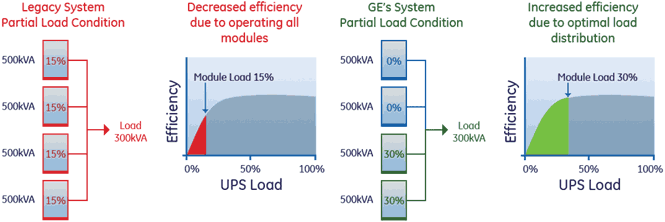
Intelligent Sync Module (ISM)
For System + System (2N) applications, the ISM module is utilized to synchronize the outputs of two modules or two groups of UPS’s that are fed from separate and independent sources. This allows the two systems to be synchronized for down-stream switching. The ISM is an intelligent control that is mounted external from the UPS module.
It has the ability to select which system is master and can also send/receive permissive signals from downstream devices. Additionally, the ISM follows the same tradition as RPA with redundancy in all critical components. The ISM communicates via redundant communication cables and has options for redundant power supplies and control circuitry.
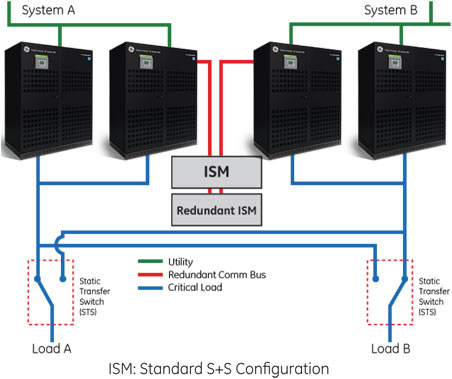
Technical Specifications
Technical Specifications
